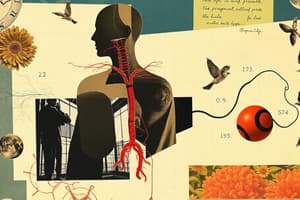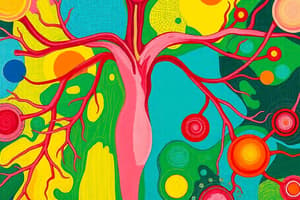Podcast
Questions and Answers
What is the primary function of adrenocorticotrophic hormone (ACTH)?
What is the primary function of adrenocorticotrophic hormone (ACTH)?
- Stimulate the adrenal gland to release corticosteroids (correct)
- Trigger uterine contractions during childbirth
- Assist in growth and puberty regulation
- Stimulate metabolism by increasing thyroid hormone levels
Which hormone is responsible for stimulating the synthesis and secretion of thyroid hormone?
Which hormone is responsible for stimulating the synthesis and secretion of thyroid hormone?
- Luteinizing Hormone (LH)
- Follicle Stimulating Hormone (FSH)
- Growth Hormone (GH)
- Thyroid Stimulating Hormone (TSH) (correct)
Which releasing hormone is responsible for the secretion of Growth Hormone (GH)?
Which releasing hormone is responsible for the secretion of Growth Hormone (GH)?
- Growth hormone-releasing hormone (GHRH) (correct)
- Corticotropin-releasing hormone (CRH)
- Thyrotropin-releasing hormone (TRH)
- Gonadotropin-releasing hormone (GnRH)
What is one function of oxytocin released from the posterior pituitary gland?
What is one function of oxytocin released from the posterior pituitary gland?
What happens if the hypothalamus fails to release releasing hormones?
What happens if the hypothalamus fails to release releasing hormones?
What is the primary role of cortisol in the body during stressful situations?
What is the primary role of cortisol in the body during stressful situations?
Which condition is characterized by excess secretion of cortisol?
Which condition is characterized by excess secretion of cortisol?
What triggers the secretion of glucocorticoids such as cortisol?
What triggers the secretion of glucocorticoids such as cortisol?
What can occur in the body due to high levels of cortisol?
What can occur in the body due to high levels of cortisol?
In Addison's disease, what are the effects of low cortisol and aldosterone?
In Addison's disease, what are the effects of low cortisol and aldosterone?
What class of hormones operates primarily through receptors located inside their target cells?
What class of hormones operates primarily through receptors located inside their target cells?
Which type of feedback mechanism amplifies a signal rather than suppressing it?
Which type of feedback mechanism amplifies a signal rather than suppressing it?
Which mechanism for hormone release is primarily driven by changes in the levels of ions or nutrients in the blood?
Which mechanism for hormone release is primarily driven by changes in the levels of ions or nutrients in the blood?
Where are neurohormones such as Oxytocin and Vasopressin produced?
Where are neurohormones such as Oxytocin and Vasopressin produced?
What key function does negative feedback serve in hormone regulation?
What key function does negative feedback serve in hormone regulation?
What is the primary function of endocrine glands?
What is the primary function of endocrine glands?
Which of the following best describes neurohormones?
Which of the following best describes neurohormones?
Which type of hormone primarily stimulates glands rather than target organs directly?
Which type of hormone primarily stimulates glands rather than target organs directly?
Which of the following is a purely endocrine organ?
Which of the following is a purely endocrine organ?
In the context of hormone signaling, what does autocrine signaling refer to?
In the context of hormone signaling, what does autocrine signaling refer to?
What is a primary role of the endocrine system?
What is a primary role of the endocrine system?
What role do receptors on target cells play in the endocrine system?
What role do receptors on target cells play in the endocrine system?
Which option correctly describes pheromones?
Which option correctly describes pheromones?
What term is used for hormones that regulate neighboring cells?
What term is used for hormones that regulate neighboring cells?
Which of the following correctly describes the endocrine system?
Which of the following correctly describes the endocrine system?
How do hormones primarily exert their effects on target cells?
How do hormones primarily exert their effects on target cells?
What role does the hypothalamus play in the endocrine system?
What role does the hypothalamus play in the endocrine system?
Which structure is directly attached to the hypothalamus?
Which structure is directly attached to the hypothalamus?
What is the function of the hypophyseal portal system?
What is the function of the hypophyseal portal system?
Which of the following hormones is released from the anterior pituitary gland?
Which of the following hormones is released from the anterior pituitary gland?
What type of hormones does the posterior pituitary gland primarily release?
What type of hormones does the posterior pituitary gland primarily release?
Which hormone is involved in breast development and milk production?
Which hormone is involved in breast development and milk production?
How is hormonal release from the anterior pituitary gland primarily regulated?
How is hormonal release from the anterior pituitary gland primarily regulated?
Which part of the pituitary gland is considered a 'true endocrine gland'?
Which part of the pituitary gland is considered a 'true endocrine gland'?
What is the primary effect of T3 and T4 on the body's metabolism?
What is the primary effect of T3 and T4 on the body's metabolism?
Which hormone is primarily produced by the parafollicular (C) cells of the thyroid gland?
Which hormone is primarily produced by the parafollicular (C) cells of the thyroid gland?
Why is T4 considered a prohormone?
Why is T4 considered a prohormone?
What condition results from a deficiency in thyroid hormone (TH) during mid-gestation?
What condition results from a deficiency in thyroid hormone (TH) during mid-gestation?
What effect does calcitonin have on osteoclast activity?
What effect does calcitonin have on osteoclast activity?
What is the potential consequence of too much growth hormone (GH) during childhood?
What is the potential consequence of too much growth hormone (GH) during childhood?
Which thyroid hormone is more potent and preferred by nuclear receptors?
Which thyroid hormone is more potent and preferred by nuclear receptors?
What does a goitre typically indicate?
What does a goitre typically indicate?
Flashcards
Endocrine System
Endocrine System
Organs and tissues that secrete hormones into the bloodstream.
Hormones
Hormones
Chemical messengers produced by endocrine cells that travel through the bloodstream to target cells.
Endocrine Glands
Endocrine Glands
Glands that release hormones directly into the bloodstream, without ducts.
Target Cells
Target Cells
Signup and view all the flashcards
Autocrine Hormones
Autocrine Hormones
Signup and view all the flashcards
Paracrine Hormones
Paracrine Hormones
Signup and view all the flashcards
Endocrine Hormones
Endocrine Hormones
Signup and view all the flashcards
Pheromones
Pheromones
Signup and view all the flashcards
What is ACTH's role?
What is ACTH's role?
Signup and view all the flashcards
What does Growth Hormone regulate?
What does Growth Hormone regulate?
Signup and view all the flashcards
What is ADH's function?
What is ADH's function?
Signup and view all the flashcards
What is the role of the hypothalamus?
What is the role of the hypothalamus?
Signup and view all the flashcards
What is the significance of the anterior pituitary gland?
What is the significance of the anterior pituitary gland?
Signup and view all the flashcards
Lipid-soluble Hormones
Lipid-soluble Hormones
Signup and view all the flashcards
Homeostasis
Homeostasis
Signup and view all the flashcards
Negative Feedback
Negative Feedback
Signup and view all the flashcards
Neurohormones
Neurohormones
Signup and view all the flashcards
Catecholamines
Catecholamines
Signup and view all the flashcards
Neuroendocrine Cells
Neuroendocrine Cells
Signup and view all the flashcards
Humoral Regulation of Hormone Release
Humoral Regulation of Hormone Release
Signup and view all the flashcards
Neural Regulation of Hormone Release
Neural Regulation of Hormone Release
Signup and view all the flashcards
Hypothalamus
Hypothalamus
Signup and view all the flashcards
Pituitary Gland
Pituitary Gland
Signup and view all the flashcards
Hypophyseal Portal System
Hypophyseal Portal System
Signup and view all the flashcards
Hypothalamic Neurohormones
Hypothalamic Neurohormones
Signup and view all the flashcards
Anterior Pituitary Gland (Adenohypophysis)
Anterior Pituitary Gland (Adenohypophysis)
Signup and view all the flashcards
Posterior Pituitary Gland (Neurohypophysis)
Posterior Pituitary Gland (Neurohypophysis)
Signup and view all the flashcards
Trophic Hormones
Trophic Hormones
Signup and view all the flashcards
Renin-angiotensin-aldosterone system
Renin-angiotensin-aldosterone system
Signup and view all the flashcards
Cortisol
Cortisol
Signup and view all the flashcards
HPA axis
HPA axis
Signup and view all the flashcards
Cushing's syndrome
Cushing's syndrome
Signup and view all the flashcards
Addison's disease
Addison's disease
Signup and view all the flashcards
What is a goitre?
What is a goitre?
Signup and view all the flashcards
Where is the Thyroid gland located?
Where is the Thyroid gland located?
Signup and view all the flashcards
What are T3 and T4?
What are T3 and T4?
Signup and view all the flashcards
What is Calcitonin?
What is Calcitonin?
Signup and view all the flashcards
What is Thyroglobulin?
What is Thyroglobulin?
Signup and view all the flashcards
What is the colloid lumen?
What is the colloid lumen?
Signup and view all the flashcards
What are parafollicular cells?
What are parafollicular cells?
Signup and view all the flashcards
What effect do T3 and T4 have on the BMR?
What effect do T3 and T4 have on the BMR?
Signup and view all the flashcards
Study Notes
The Endocrine System
- The endocrine system is a system of ductless glands that secrete hormones into the bloodstream.
- These hormones are chemical messengers that regulate, integrate, and control many physiological functions throughout the body.
- The system includes both purely endocrine organs and endocrine cells within other organs.
Components of the Endocrine System
- Endocrine glands: Ductless glands comprised of endocrine cells.
- Hormones: Chemical messengers produced by endocrine cells and secreted into the bloodstream.
- Hormones are classified as peptides, amino acid derivatives, or steroids.
Types of hormones
- Peptide hormones: Chains of amino acids. Synthesized on ribosomes and stored in vesicles.
- Amino acid derivatives: Derived from tyrosine or tryptophan. Examples include catecholamines (epinephrine, norepinephrine) and thyroid hormones (T3 and T4).
- Steroid hormones: Derived from cholesterol. Examples include cortisol and aldosterone. They are lipid-soluble and bind to intracellular receptors.
Hormone Receptors
- Hormone receptors are located on the surface, in the cytoplasm, or in the nucleus of target cells.
- Receptors are specific to particular hormones. Only hormones that bind to specific receptors can activate those receptors and trigger a cellular response.
- Hormones that do not bind to their receptor have no effect.
How Hormones Act
- Hormones usually act over long distances, but can also function paracrine or autocrine.
- Paracrine regulators affect neighboring cells, and autocrine regulators affect the cells that produce them without entering the bloodstream.
- Hormonal release is controlled by positive and negative feedback mechanisms.
Mechanisms of Hormone Release
- Humoral: In response to changing levels of ions or nutrients in the blood.
- Neural: Stimulation by nerves
- Hormonal: In response to signals from other hormones
Homeostasis
- Homeostasis is the maintenance of the body's internal environment in a steady state. Hormonal regulation is essential for homeostasis.
Positive and Negative Feedback
- Negative feedback: Regulation of the output of the hormone to maintain a stable internal environment.
- Positive feedback: Amplifies a signal (e.g., childbirth).
The Hypothalamus and Pituitary
- The hypothalamus and pituitary gland are the primary regulators of hormonal signals.
- The hypothalamus releases releasing hormones (RH) to stimulate the synthesis and release of specific anterior pituitary hormones. It also releases inhibiting hormones (IH) to stop the synthesis and release of hormones.
- The pituitary gland (divided in anterior and posterior sections) produces a range of hormones (e.g., TSH, ACTH, GH, LH, FSH) vital for bodily function.
Pituitary Gland
- The pituitary gland, also called the hypophysis, sits below the hypothalamus.
- The anterior pituitary is called the adenohypophysis, while the posterior pituitary is called the neurohypophysis.
- The anterior pituitary produces several hormones that affect other endocrine glands and body tissues, while the posterior pituitary stores and releases hormones produced in the hypothalamus.
The Hypothalamic-Pituitary Axis
- This system connects the hypothalamus to the pituitary gland and controls hormone release.
- The hypothalamus secretes hormones that either stimulate or inhibit the release of hormones from the pituitary. This system is also essential for feedback mechanisms that maintain balanced hormone levels..
The Thyroid Gland
- The thyroid gland is located in the anterior neck, on the trachea. It has two lobes and an isthmus.
- It produces two primary hormones: thyroxine (T4) and triiodothyronine (T3) which regulate metabolism. They are dependent on iodine.
- Calcitonin, also produced by the thyroid, is involved in calcium and phosphorus metabolism.
The Parathyroid Glands
- These four glands are located on the posterior surface of the thyroid gland.
- They produce parathyroid hormone (PTH), which regulates calcium homeostasis levels in the blood.
The Adrenal Glands
- The adrenal glands sit on top of each kidney.
- They are composed of the adrenal cortex (outer) and adrenal medulla (inner), with each producing different hormones.
- The adrenal cortex produces steroid hormones like cortisol and aldosterone, vital for stress responses and fluid and electrolyte balance.
Cortisol
- Cortisol is a glucocorticoid essential for life, helping the body respond to stressful situations.
- It regulates diverse functions like blood glucose, metabolism, immune response and water balance.
- Cortisol is important for the response to stress, while the adrenal medulla produces epinephrine and norepinephrine for rapid response to stress.
Pathology
- Problems with hormone production or function, such as goiters, hyperthyroidism (overactive thyroid), hypothyroidism (underactive thyroid), hyperparathyroidism (overactive parathyroid), hypoparathyroidism (underactive parathyroid), Cushing’s syndrome (excess cortisol) and Addison’s disease (inability to produce enough cortisol and aldosterone) can occur and have various symptoms for each specific pathology.
Studying That Suits You
Use AI to generate personalized quizzes and flashcards to suit your learning preferences.




